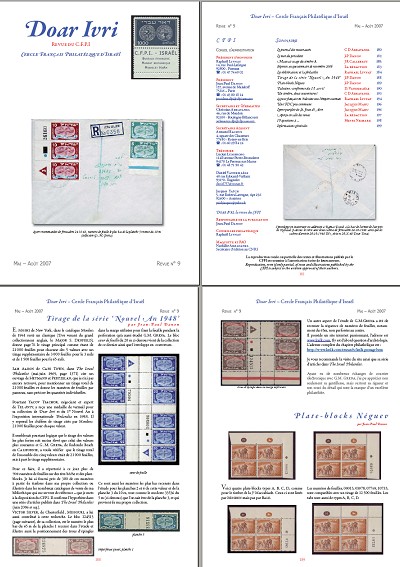
It's published by Cercle Francais Philatelique d'Israel, & the current president is Jean-Paul Danon, who also authored the 2-page article entitled "Tirage de la Serie 'Nouvel An 1948'".
On the cover is a photo of an envelope in my collection, covered by Jerusalem "24-10-1948" postmarks, & 2 semi-rare blocks of LMLK stamps including margin/gutter elements.
Because of a miniscule notch in the blue band of the 5-mil block, we can positively identify not only the pane of these 2 stamps (#6), but their exact position on the sheet of 300 stamps: K02 & K03 (with the margin being K01).
Furthermore, the contents were addressed to a lady-soldier, Miriam Eichelberg, at the Ramat David army base near Nahalal. (Thanks to the father of the anonymous antiquities collector in Boston for this translation of her name!)
The back of the cover (shown on the Table of Contents page in the photo above) was also covered by 2 more of the same marks used on the front, plus a "26-10-1948" Tel Aviv mark, & a rare army postmark for Doar Tzvai (DAR $BAY) the same day, "26-X-48".
But none of those interesting tidbits made me acquire this envelope! The real reason I bought it was that right now, the serial number on the 10-mil block represents the lowest-known number for the 10-mil sheets: 26160 (pane 4 would be 05160). And that's the main focus of Jean-Paul's article on pp. 188-9.
In the photo of these 2 pages above, you can see a large blue 20-mil sheet-heart from my collection, which currently represents the lowest-known sheet number for that denomination: 79504/100504 (pane 4 would be 16504).
Below this you can see another record-setting specimen for the 5-mil sheets in Jean-Paul's collection, a tete-beche pair with the lowest-known number for it: 33536 (pane 4 would be 12536).
The highest-known 5-mil number is in my collection, but not shown in the article--a tete-beche with margin attached: 121493.
At the bottom of p. 188 is a rare imperforate tete-beche from the 65-mil sheets. By tracking which serial numbers have imperf gutters, we can learn clues related to their rarity. This particular configuration was limited to a group of about 100 sheets (not mentioned in the article because my research is ongoing).
The top of p. 189 contains the lowest-known 65-mil supplementary printing sheet number from the collection of Victor Silver: 124513 (pane 4 would be 19513). This block has another rare feature--the pinhole pair in the margin is shifted to a slightly different position than that seen on most sheets. Rather than straddling the perforation line, they appear well-centered in cell H01.
Congratulations to Jean-Paul Danon for being elected president of C.F.P.I., for his excellent contributions to this publication, & for winning a gold medal at the FFAP (Federation Francaise des Associations Philateliques) national exhibition in Poitiers last week!
Song of the week: "Close Cover" by Wim Mertens (click the song title to visit Amazon; click here for a 25-second sample; 328kb).
G.M. Grena

No comments:
Post a Comment